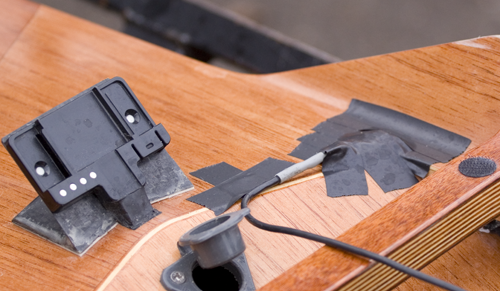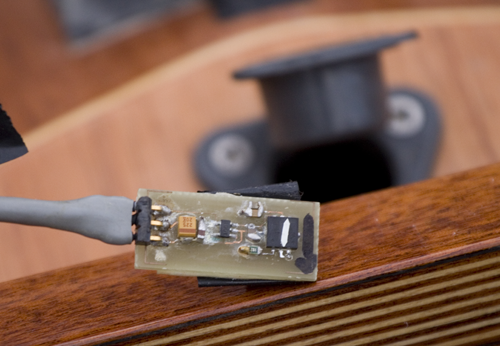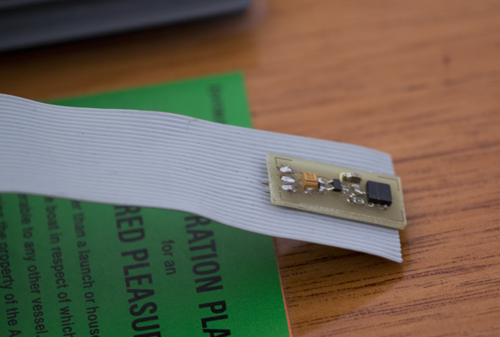|
|
About the Accelerometer Setup
The setup comprises 2 tiny thumbnail-sized +/- 2g accelerometers each with a longish lead and a standard jackplug. One lead is an ordinary electrical lead, while the other is computer ribbon which folds over and back in motion in a predictable linear fashion, so that the accelerometer can be attached to the moving seat of a boat, while the other end is plugged into the datalogger. The datalogger has circuitry and onboard memory to record the acceleration data as it comes in and collects simultaneous data from the 2 accelerometers every 1/1000th of a second with enough capacity for 4 minutes of data. This allows a very detailed look into the motion of whatever it's connected to.
Much of the data collected and presented herein is gathered using one accelerometer on the shell and one on the seat of a boat. This allows the shell movement to be analysed, and also the seat-within-the-boat data to be analysed to provide reference points (e.g. the exact moment of frontstops) for the otherwise potentially impenetrable acceleration chart. Also, knowing the mass of the shell and the mass of the rower, the data from the 2 accelerometers can be combined to give a good estimate of the motion of the centre of mass of the whole rower-shell system. It was designed and built on the basis of our conversations by Peter Beeson, formerly an electronics engineer at Nokia, now with LA Techniques, and a skilled skiff restorer, ornithologist and general polymath. |
|
Acceleration Chart Introduction
The chart below shows a typical presentation of data from the accelerometer set-up (one accelerometer on the shell, one on the seat). In this case the sculler is a very good sculler, and he is recorded doing a race-pace piece, rate around 32, incidentally against a coxed 4 who happened to come alongside. 8 seconds of sculling is plotted: 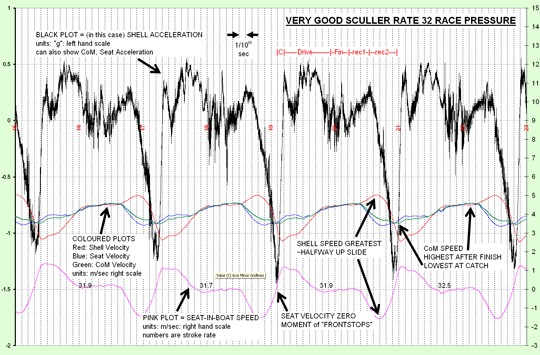
The top plot is the acceleration itself, in this case of the shell, but could equally well have been that of the seat, the seat-within-the-shell or the centre of mass. The middle set of interweaving plots are velocities (integrations of the accelerations) and occur in three colours, red, blue and green. -- The red plot is shell velocity, obtained via direct integration of the shell acceleration data. -- The blue plot is seat velocity, similarly obtained from the seat data. -- The green plot is Centre of Mass velocity, a weighted-by-mass combination of the seat and shell data. -- The bottom plot, the pink one, is the velocity of the seat within the boat, and helps provide a reference for the various different parts of the stroke. The rest of this "accelerometer" section is devoted to more in-depth studies of particular ideas or comparisons. Whether it proves actually useful rather than simply interesting remains to be seen. |
|
Is the Fixed-Head Erg Good for Sculling/Rowing?
Take a look at the chart below. The top pair of plotted points, the "jagged" ones, are plots, using my accelerometers, of the recorded net acceleration (i.e. force per kg) experienced by the body in a sculling boat (black plot) and on a fixed-head ergometer (red plot). The bottom pair, much smoother, are the velocities experienced by the same bodies, again red for erger, black for sculler. The erg and sculling plots have been overlaid and aligned so that the moments of frontstops coincide (dotted vertical lines). The stroke rates were the same, and the erger and sculler were the same person on the same day working at the same intensity. These data show how differently the body of a rower experiences a fixed-head ergometer from how it feels the motion of an actual rowing boat. Ergometer & Scull: Acceleration & Velocity Felt by the Rower over ~4 strokes 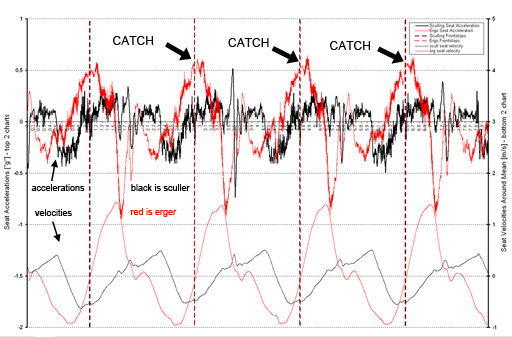
(Note: the moments of frontstops have been aligned between the erg and the scull, and the rates
were the same.)
The chart may or may not make any sense for now, but let me step back and return to the question heading this article: "Is the Fixed-Head Erg Good for Sculling/Rowing?" There is no doubt that the ergometer has made a tremendous contribution to reducing rowing times via improved training, measurement of and selection for power output. However, I believe that this net improvement has masked a damaging feature of the fixed-head ergometer, in that it has serious potential to confuse or interfere with the feeling a rower has for the subtle dynamics of a crew. How many "ergo-boats" have you seen which markedly underperform their potential based on ergscore? The damage has been done in two ways: Firstly, before the invention of the ergo there were as many uncertainties in independently estimating an individual's power contribution as there were in gauging technical merit. With the advent of the ergo and the sudden ease of measuring individuals' relative physiological strengths, technical considerations have been given more of a back seat: all too often they have been put into the "too hard" box and the door closed. Secondly, prolonged use of a fixed head ergometer during the racing season will seriously interfere with the build-up of muscle memory required to allow a crew to "gel". The erg "feels" completely different from the boat, even though superficially it looks the same: the body is going through more or less the same sequence of positions as a rower. "WEIGHT ON THE FEET" For example, next time you're sitting on an erg and pulling some strokes, as you approach frontstops take particular notice of the tremendous build-up of pressure under your feet, and note also that this pressure builds up well before the catch. This huge under-foot pressure before the catch simply doesn't happen in a properly-rowed boat, where in fact most of the recovery should be spent with feet pulling not pushing (see also here for more about the recovery and how critical it is). Just before the catch in a boat, the foot-pull briefly turns into a small "push" as the mass of the boat needs to be decelerated to the same speed as the rower. This is where I return to the chart as evidence, which actually shows the foot-push. The top two plots, showing force on the body, shows the (red) erger's force climbing to a maximum approaching the catch. Note also that this is a much higher maximum than the sculler ever experiences. Ergometer & Scull: Seat Acceleration & Velocity - annotated 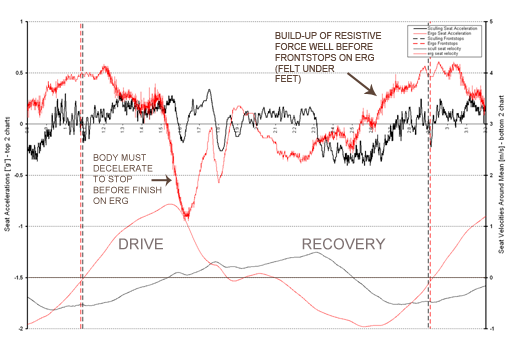
This erg-related under-foot pressure-build-up, although highly undesirable, probably can be replicated in a crew boat, but only by using the inertia of one or more members of the same crew to resist against during the recovery. If anyone is doing this, by definition the crew cannot be executing the recovery together, and the crew will feel appalling. It is a theory of mine that this is in fact partly what occurs in "ergo-boats" which go slowly and feel worse -- some people are simply trying to replicate that "ergo feel" in the boat by using other crew-mates as inertial resistance - ugh! Thus the expression "get the weight over onto the feet", much used by coxes and coaches, is perfectly applicable to a fixed-head ergometer, but TOTALLY INAPPROPRIATE for rowing and sculling, and if obeyed by the crew can only be disastrous. LAST HALF OF THE DRIVE Another feature of the erg experience without an equivalent in the boat is that huge red dip in the top (red) erg chart. On the erg after the catch you must move away from the standstill at frontstops, and come to a halt again at backstops. This means your whole body must accelerate away from the catch and then decelerate back to a standstill for the finish. These accelerations are felt by the body as major forces which, once again, simply do not happen in a boat, where the only significant forces your body experiences are a gentle acceleration (relative to forces felt on the erg) as work is applied in the drive, and a slightly less gentle deceleration during the recovery, as both water drag plus the backwards force felt as you pull the shell underneath you, act together. SLIDING DISTANCE:IN-BOAT vs ERG Another interesting comparison is that, for this athlete at least, actual sliding distance is 60cm on the erg and 45cm in the boat, fully 33% more on the erg! The difference is due to the sheer momentum of the body on the erg having to be brought to zero and carrying the body further up the rail, as opposed to only having to halt the closing speed of the much lighter shell, which is already and also being slowed down by the water drag. Thus it is probably unreasonable to expect people to compress as much in a boat as on an erg. SUMMARY All in all, although on the face of it the fixed-head ergometer appears a good simulation of rowing in a racing shell, it absolutely is not. The forces you experience are completely different, the amount of compression is completely different, and there is an all-too-often seen propensity for rowers to destroy the cohesion of the crew, trying to emulate in a boat (wittingly or otherwise) the "meaty" feeling of the fixed-head erg. A far better alternative, as can be seen even in my rudimentary article here, is a floating-head ergometer such as the Rowperfect EXTRA BIT: COMPARISON OF MEASURED ERGO RECOVERY FORCES WITH THEORETICAL USING MATHEMATICAL MODEL OF RECOVERY It would be interesting, as an easy test of my mathematical model of the recovery (used here and more formally described here), to see how the model predictions stand up to experiment. The situation of a fixed-head ergometer is applied to the model, which requires mass of boat and rower as inputs, by fixing the mass of the "boat" as a very large number, say 10^9 kg while keeping the mass of the rower as is. The two charts below have been arranged that they show the results in more or less the same "shape". The top plot shows the actual measured speed profile of this athlete on the actual erg. The bottom plot shows the speed profile of the ergo seat, idealised as a sine curve. Similarly the top plot shows the measured force (acceleration) actually experienced by the seat, which should be compared to that predicted by the model in the bottom plot. You can see that actually the shapes and the magnitudes of the data match quite well, implying that the model in this case works quite well, or that the accelerometer works well, or both. Ergometer: MEASURED Inertial Force and Seat Velocity Felt by the Athlete - Recovery Only 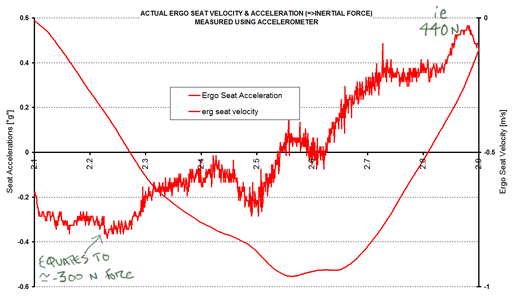
Ergometer: MODELLED/THEORETICAL Inertial Force and Seat Velocity Felt by the Athlete - Recovery Only 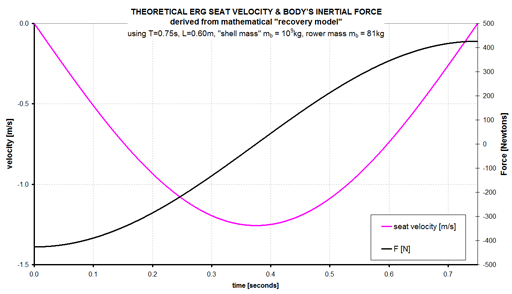
|
|
How the Centre of Mass Moves
You often hear phrases such as: "move the boat!", "sit the boat", "such and such is / is not a boatmover". Much analysis and many instruments are designed to study boat acceleration, boat velocity, etc etc. In other words, all the talk is about the boat. But it shouldn't be. The boat only makes up a tiny proportion of the mass that needs to be propelled to the finish line, but you never hear similar attention being given to the body alone, except as it relates to moving the body within the boat (a viewpoint which is itself an error: see Recovery Technique.). Rather than consider the movement of the boat in isolation, or the body in isolation, the only comprehensive way to analyse or think about what's going on is to consider the rower/crew/boat system as a whole, namely the Centre of Mass. The centre of Mass is a non-directly-observable location in space sitting at the weighted (no pun intended!) average position of the centres of masses of the boat and crew. If one could observe it, one would expect to see a very simple pattern: the CoM ought to accelerate (speed up) while propulsion is being applied, and decelerate (slow down) while work isn't being applied, and there should be less of the dramatic accelerations and decelerations you see when measuring the movement of the shell alone. The accelerometer set-up with one on the seat and one on the shell, and knowing the mass of rower/s and shell, allows one to actually reconstruct the movement of the CoM. Below I have presented three plots, one of me at maximum speed/pressure, one of me in a 3-minute piece, and one of a crewmate doing a 3-minute piece in quite rough water. Note that: 1. the CoM starts to increase speed approximately 1/10th second after the moment of full slide 2. intriguingly the CoM speed keeps increasing all the way to the start of the recovery - there wasn't a tailwind and I wish I had some synchronised video to actually see what's going on here. My preferred theory is that since the accelerometer is attached to the seat, the body-swing appears in the data as a continued acceleration of the system. Thus I think that the true start of the decline in CoM velocity should be around halfway through the period at which seat and shell are together, i.e. just after the blades get extracted. I have assumed this when estimating the "drag factor" in my consumption of humble pie when talking about the Run of the Boat in the "howtorow" section. 3. the CoM speed does indeed appear to increase and decrease nearly linearly as described above. 4. the pronounced wobble at the end of my drive (1st 2 pictures) is also interesting, I'm not sure I can explain it for now...interesting that it is not a feature of the other sculler plotted here (pic 3) 5. in the third picture, the sculler has an old (Janousek) boat with worn, pitted, gritty rails. This may explain the apparent noise in his velocities at the second half of his recovery. 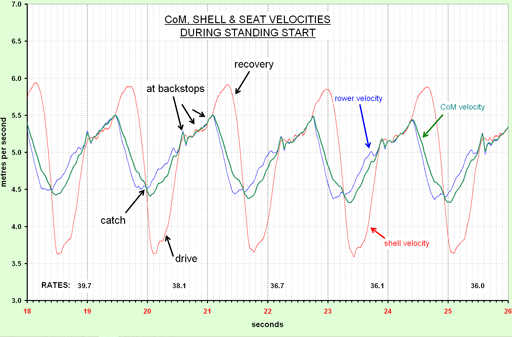
The first picture shows these velocities, of the author shortly after a standing start. This is sculling at my most violent, trying to achieve maximum possible speed. 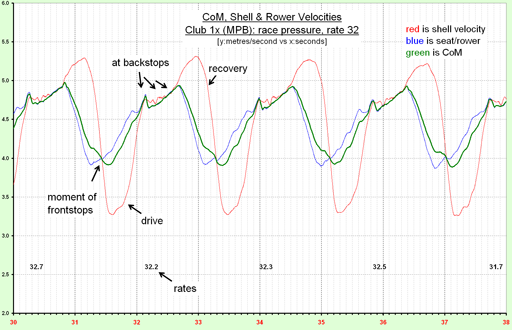
The second picture is the author again, this time in a 3 minute race-pace piece, the second of 6. 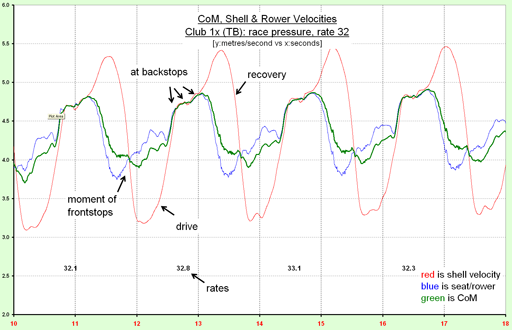
The third picture is another Molesey member, (bowman in banner picture at top of page, incidentally) not particularly powerful but quite a good sculler doing a 3 minute race-pace piece in rough water. |
|
Rowperfect vs Sculling
Here are two images to illustrate a recent thread on rec.sport.rowing. In each case the large depression followed by the sharp rise represents the approach to frontstops and the catch, respectively. The sculler is a technically superb sculler who has a reputation for beating people of vastly superior erg-score. The rowperfect plot, for now, is the author. SCULLING SHELL ACCELERATION 8 seconds of race-pace sculling rate ~30. black = acceleration[lhs, 'g']. x axis in seconds. red = shell velocity[rhs, m/s]. pink = seat velocity[rhs, m/s] ROWPERFECT HEAD ACCELERATION 8 seconds on the Rowperfect. x axis in milliseconds. N.B: done in civilian clothes, totally un-warmed-up, half pressure. (Will replace in due course with better more comparable session) |
|
SlidingSeat.net / Magnus Burbanks / member of Molesey Boat Club, UK
|
|
A description of the instrument, what inspired it, who built it and what uses it
might have. An annotated example of a typical plot of data from the instrument, showing shell
acceleration over 4 strokes, and velocity of shell, rower and Centre of Mass. No! Except as a fitness/conditioning tool. A comparison of forces an
athlete experiences on a fixed-head ergometer versus
in a single, which shows that the body of an erger experiences much greater and sometimes opposite forces
from the rower at the same parts of the stroke, and that the expression "get the weight over" is a very bad thing to say.
An analysis of how the CoM of the boat/rower speeds up and slows down as
the rower draws the shell in and drives it away each stroke. A simple comparison of the forces a shell experiences versus the floating head
of a Rowperfect, which shows that the Rowperfect seems to emulate sculling pretty well. |
